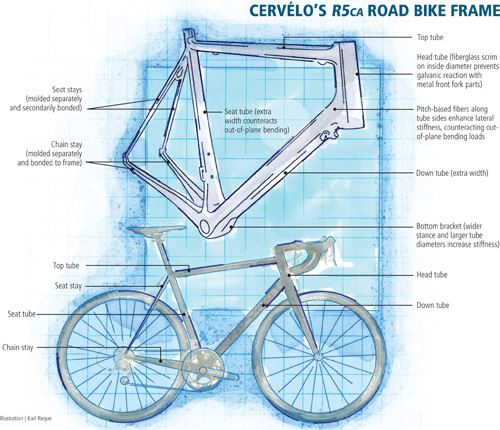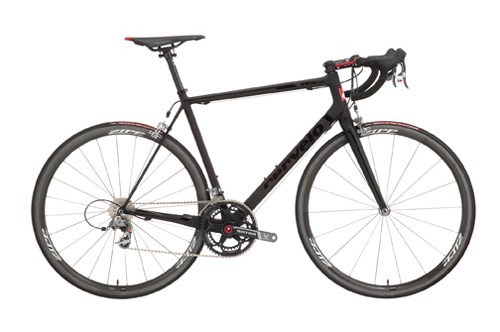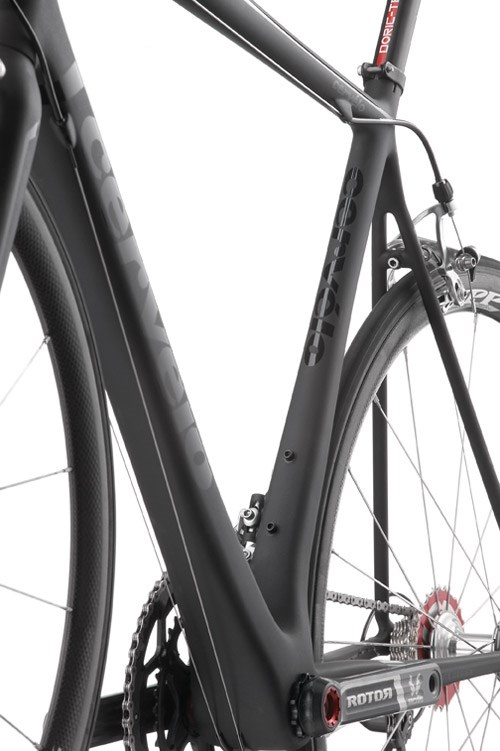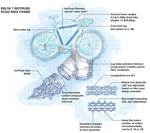Designing bicycling’s lightest pro racing frame
Cervélo’s Vroomen White Design group combines analysis and manufacturing acumen to create a 675g/1.5 lb composite frame.
Engineering Challenge:
Optimize a racing bicycle design for ultimate performance, using the design flexibility of composites, a suite of analytical design tools and improved manufacturing techniques.
Design Solution:
Use a unique carbon/epoxy prepreg layup to manufacture the lightest professional bike frame ever produced yet still meet all safety and performance requirements for racing conditions.
Design and manufacturing can’t be separated; they need to be done in parallel,” declares Don Guichard, director of technology and manufacturing at Vroomen White Design’s Project California research and development facility, the wholly owned engineering group of Cervélo (Toronto, Ontario, Canada). That point of view has helped propel Cervélo to prominence in professional bicycle racing and led to the recent introduction of the lightest professional bicycle frame. At a mere 675g/1.5 lb, Cervélo’s R5ca bike’s frame weighs less than a quart of water.
The R5ca grew out of the company’s desire to develop a better process for creating its composite bicycles by integrating design and analysis tools, testing regimes and manufacturing in its self-contained Project California facility. There, the design team’s depth of experience coupled with the freedom provided by Cervélo’s owners, Gerard Vroomen and Phil White, made it possible. “Usually, in the bike industry much of a new project is predefined by marketing before an engineer ever sees it,” says Richard Matthews, Vroomen White Design’s senior composites engineer. “We’re lucky that Cervélo started with a performance goal and allowed us the latitude to develop both the tube shapes and the composite part layups.”
Designing the lightest bicycle
“It would be easy to make a lighter bicycle by just removing material — but we didn’t do that,” Guichard emphasizes. The key to the R5ca’s design, he explains, is the use of highly tailored and complex composite fiber architecture to accomplish something that simply can’t be done, for example, in an aluminum frame: balance the many, usually conflicting, high-end performance requirements. To meet safety criteria imposed by the Comité Européen de Normalisation (CEN, Brussels, Belgium), a bike frame must exhibit high strength and the ability to absorb a lot of energy, including energy from a head-on impact of the front fork with an obstacle, yet it also must possess high torsional stiffness to transfer seat and pedal loads and provide good handling. However, too much stiffness compromises rider comfort, so some compliance or flexibility is needed in the plane of the frame. Composites, designed using nonuniform and directional ply layups, made it possible to combine these properties in one frame.
The Vroomen White Design team used several design tools to help untangle the many performance goals. Starting with their Squoval (“square oval”) frame concept for a road bike, they used SolidWorks from Dassault Systèmes SolidWorks Corp. (Concord, Mass.) to model the initial frame, reports Matthews. The aerodynamic was not a design driver on this frame, as they would have been for a time-trial bike. Then the SolidWorks model was input to the company’s internal CETOP preprocesser tool, says Matthews. This program creates a rough finite element analysis (FEA) grid that, coupled with basic laminate theory calculations, allows for rapid iteration of design ideas. The Squoval concept moves more material away from the center plane of the frame, which yields greater stiffness with less material. The CETOP program enabled engineers to quickly conduct analyses of the tube shapes and material layup under various loads.
With the frame design roughed out, the team moved into a more detailed FEA analysis. The preliminary results were input back into SolidWorks coupled with NEi Nastran from NEi Software (Westminster, Calif.) to create a detailed shell model that permitted them to apply multiple load cases as they optimized the final composite layup. The Vroomen White Design team was assisted in this process by Laminate Tools software from Anaglyph Ltd. (London, U.K.), which helps define the composite materials, plies and layup scheme using a state-of-the-art graphical user interface. Says Guichard, “We really like Laminate Tools because it allows you to define layup patterns easily using finite elements without having to define ply edges in the surface model, making it very adaptable for lots of iterations. With other packages that require edge definitions in the CAD surface model, the hundreds of surfaces we would have to change for each iteration in this complex part make them unusable.”
Adds Matthews, “I think people tend to think of bicycles as simple, nonaerospace parts, but in reality the components and the load paths are very complex and difficult to analyze.” Indeed, the modeling process ultimately identified approximately 350 unique prepreg plies in the entire frame structure.
Prototypes were fabricated for testing to validate the design. Project California includes a far-reaching testing regimen that is much broader than those used by most bike manufacturers, says Guichard: “We decided, early on, that existing bike lab tests do not accurately reflect reality and, in fact, make incorrect assumptions about where each tube on a bike frame carries the most load during certain ride conditions, which was verified with our ‘strain gage’ bike.” Outfitted with sensors and ridden hard, the instrumented bike showed that bending and torsional loads in race conditions were distributed in the frame differently than existing simulations indicated. Cervélo uses more than 15 different tests, including the new load cases that take into account riding styles, such as carving curves on a fast descent or vigorous out-of-the-saddle pedaling, which puts high strain on the chain stays, down tube and bottom bracket. Cervélo also uses testing loads that exceed industry norms by at least 20 percent. Front fork impact, which CEN defines as 47 joules (35 ft-lb/ft), is tested in Cervélo’s lab at 87 joules (64 ft-lb/ft), an increase of 87 percent. The strain gage data, coupled with the actual frame tests and the Anaglyph software, allowed the team to tweak the composite layup multiple times to add more strength and stiffness in the tubes where needed, yet keep overall material usage low to hit the weight target.
Several significant geometry changes came out of the design, says Matthews. For example, the bottom bracket, which puts significant load on the rear of the frame, was redesigned with a wider stance and larger tube diameters to help maximize overall system stiffness. He explains: “Our analysis showed that a larger, 30-mm [1.2-inch]axle increased the bottom bracket stiffness at a lower frame weight and also allowed the seat tube and down tube to be wider as well. This new system we developed, called BBright, is beginning to be adopted as a new industry standard.” Guichard adds that the new bottom bracket design includes bulkhead walls in the part’s interior, allowing the outer surfaces to be thinner. This leads to a mass savings of 2.2g/0.08 oz and a stiffness improvement of several percent.
Although the exact layup of the R5ca frame is proprietary, Guichard says the fiber architecture, for the most part, is carbon/epoxy prepreg, typically 80 g/m2, made with 6K MR60 intermediate-modulus carbon fiber supplied by Newport Adhesives and Composites Inc. (Irvine, Calif.). Newport also supplies HR40 high-modulus fiber for certain areas of the frame. Because pitch-based fibers generally provide better stiffness than PAN-based fibers, the team specified pitch-based YSH60A carbon fiber from Nippon Graphite Fiber Corp. (Tokyo, Japan) in a few critical areas, such as the sides of the down tube, increasing the lateral stiffness to counteract out-of-plane bending loads. A fiberglass scrim was specified for the few places, such as the seat tube, where the carbon layup comes in contact with metal. The tube wall thickness in some lightly loaded regions is less than 1.0 mm/0.04 inch and “goes up from there,” says Guichard. “This is the stiffest-performing frame Cervélo has ever made, yet we were able to reduce the weight by 25 percent while still meeting or exceeding all strength requirements,” he adds.
Precise manufacturing
The frame’s top tube, head tube, down tube, seat tube and bottom bracket were designed to be manufactured as a monocoque. The chain stay and seat stay are molded as separate pieces. The front fork is fabricated separately and is connected to the head tube via a bearing assembly. For the frame tubes, Project California has developed closely guarded manufacturing techniques for layup around inflatable latex bladders. “We are able to create the layup and prevent movement of the plies during bladder inflation and molding, which means more accurate fiber architecture and consistent wall thickness,” Guichard explains. Plies are cut using an automated cutting table from Autometrix Precision Cutting Systems Inc. (Grass Valley, Calif.). The prepreg layup with bladders is carefully loaded into two-part female steel mold cavities, then the bladders are inflated and the mold is placed in a heated platen press for cure.
After cure and removal from the mold, the frame pieces are trimmed, sanded and placed in an assembly jig for bonding and attachment of the front fork and other system components. A single-part epoxy adhesive is used for bonding the seat stay and chain stay parts to the monocoque front triangle. Even the R5ca’s cable stops are carbon composite to minimize the bicycle’s overall weight with all components installed.
Enjoy the ride
The R5ca isn’t for everyone. With a price tag near $10,000, it’s targeted to the amateur enthusiast who wants the best. Because the R5ca is made by the Project California engineers and not in a production environment, the number of units is limited. The as-manufactured bike must have weight added to it for use in Union Cycliste Internationale (UCI)-sanctioned races, such as the Tour de France, adds Matthews: “Bicycle technology has advanced faster than the racing regulations, which still maintain that heavier bikes provide more benefit.” But in the end, Cervélo believes its flagship bike has significantly advanced cycling technology, thanks to composites and composite design. Concludes Guichard, “Our investments in composites have provided us a huge palette of tools to accomplish Cervélo’s design philosophy.”
Related Content
Materials & Processes: Resin matrices for composites
The matrix binds the fiber reinforcement, gives the composite component its shape and determines its surface quality. A composite matrix may be a polymer, ceramic, metal or carbon. Here’s a guide to selection.
Read MorePlant tour: Joby Aviation, Marina, Calif., U.S.
As the advanced air mobility market begins to take shape, market leader Joby Aviation works to industrialize composites manufacturing for its first-generation, composites-intensive, all-electric air taxi.
Read MorePEEK vs. PEKK vs. PAEK and continuous compression molding
Suppliers of thermoplastics and carbon fiber chime in regarding PEEK vs. PEKK, and now PAEK, as well as in-situ consolidation — the supply chain for thermoplastic tape composites continues to evolve.
Read MoreCycling forward with bike frame materials and processes
Fine-tuning of conventional materials and processes characterizes today’s CFRP bicycle frame manufacturing, whether in the large factories of Asia or at reshored facilities in North America and Europe. Thermoplastic resins and automated processes are on the horizon, though likely years away from high-volume production levels.
Read MoreRead Next
New twist in cycling: A truss bikers can trust
An "open tube" alternative to the solid-tube bike frame.
Read MoreCW’s 2024 Top Shops survey offers new approach to benchmarking
Respondents that complete the survey by April 30, 2024, have the chance to be recognized as an honoree.
Read MoreFrom the CW Archives: The tale of the thermoplastic cryotank
In 2006, guest columnist Bob Hartunian related the story of his efforts two decades prior, while at McDonnell Douglas, to develop a thermoplastic composite crytank for hydrogen storage. He learned a lot of lessons.
Read More
















.jpg;maxWidth=300;quality=90)














